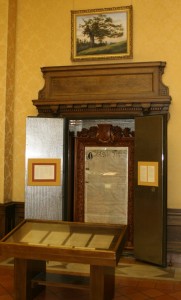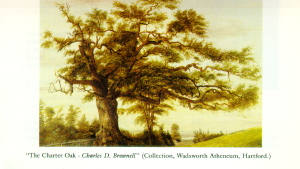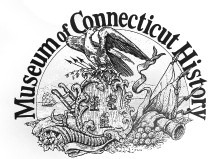 Connecticut’s history of constitutional government dates back to the seventeenth century and two significant documents: the 1639 Fundamental Orders, which bound the three original towns of Windsor, Wethersfield and Hartford into a colonial entity, and the Royal Charter of 1662 granted by Charles II. Twenty-five years later, when agents of James II attempted to seize the charter, it was spirited away and hidden in a majestic oak tree on the Wyllys estate in Hartford, thereby preserving the charter and the rights of the colonists.
Connecticut’s history of constitutional government dates back to the seventeenth century and two significant documents: the 1639 Fundamental Orders, which bound the three original towns of Windsor, Wethersfield and Hartford into a colonial entity, and the Royal Charter of 1662 granted by Charles II. Twenty-five years later, when agents of James II attempted to seize the charter, it was spirited away and hidden in a majestic oak tree on the Wyllys estate in Hartford, thereby preserving the charter and the rights of the colonists.
For over a hundred and fifty years, the “charter oak” was a prominent and widely recognized Connecticut  landmark. When it was toppled during an 1856 storm, acorns were collected as keepsakes, as were a considerable amount of twigs, leaves, branches and lumber.
landmark. When it was toppled during an 1856 storm, acorns were collected as keepsakes, as were a considerable amount of twigs, leaves, branches and lumber.
The Museum exhibit “Liberties and Legends” tells the story of this venerated icon. The exhibit includes numerous souvenirs made from wood of the original charter oak, including a Colt revolving pistol, picture frames and miniature furniture. Today, several “descendants” of the charter oak are to be found on the grounds of the State Capitol and in Hartford’s Bushnell Park. The original charter, preserved in an ornate frame made of “charter oak” wood, is prominently displayed in the museum.
Also on permanent display are the State Constitutions of 1818 and 1964 and Connecticut’s copy of the United States Bill of Rights.
